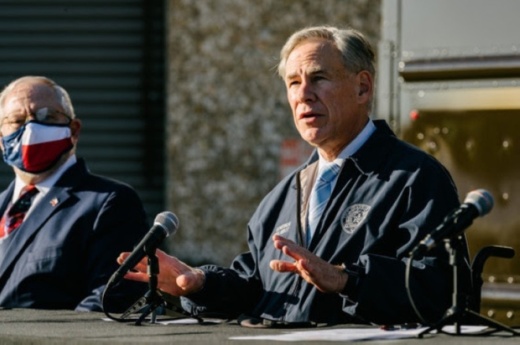Gov. Greg Abbott made the announcement March 2 at Montelongo's Mexican Restaurant in Lubbock, wiping away his previous executive orders that included requirements for state residents to cover their faces if they were traveling through indoor spaces open to the public or outdoor areas where they could not maintain 6 feet of distance. Those previous orders also required some businesses to limit their capacity to allow customers to maintain space.
The announcement comes as COVID-19 vaccine distribution across the state continues to steadily but slowly increase. According to Texas Department of State Health Services data as of March 1, more than 3.57 million Texans had received at least one dose of the vaccine, and about 1.89 million are fully vaccinated. The U.S. Census Bureau estimates the Texas population at roughly 29 million, meaning roughly 12% of state residents had received at least one dose, and about 7% had received both shots.
Abbott said the pace of vaccine distribution is picking up. The state is administering 1 million doses a week, he said, and will soon expand the categories of individuals who can receive the shot, currently limited to health care workers, those with underlying health conditions and individuals age 65 or older. By the end of March, according to Abbott, every Texas senior who wants a vaccine will be able to receive one.
For the week of March 1, DSHS officials said 676,280 additional first doses and 429,600 second doses are on the way to the state. After a third vaccine, produced by Johnson & Johnson, was approved by the U.S. Food and Drug Administration for emergency use, the DSHS said in a March 1 tweet that more than 200,000 doses will be coming to Texas the week of March 8.
At a Travis County Commissioners Court meeting the morning of March 2, before Abbott's announcement, Dr. Mark Escott, the Austin-Travis County interim health authority, said he had hoped for the mask mandate to continue for a few more weeks as vaccine distribution increased.
"My hope is that the mask mandate will continue at least through the end of April to allow us to really drive this curve down and get more people vaccinated and really eliminate the potential for a substantial surge," Escott said.
Since early January, when COVID-19 cases and hospitalizations peaked across the state, numbers have been steadily declining. According to DSHS data, there were 5,611 COVID-19 patients in Texas hospitals as of Feb. 28, down from more than 14,000 from Jan. 11-13.
Abbott said at this time, "people and businesses don't need the state telling them how to operate." However, if COVID-19 hospitalizations do rise above a certain level—15% of all hospitalizations within a certain region—county judges will be able to take action. Under state law, those actions cannot include reducing business capacity lower than 50%, imposing jail time for failing to follow COVID-19 guidelines or imposing penalties for not wearing a mask.
Local governments, including Harris County and Travis County, are still urging residents to take steps to limit the spread of the disease. Harris County is in its highest risk stage—recommending residents stay home whenever possible. Travis County is at its second-highest stage of risk, asking residents to avoid gatherings of more than 10 people and businesses to limit capacity to 25%-50%.
Before the governor's announcement, Austin Mayor Steve Adler and Travis County Judge Andy Brown unsuccessfully urged Abbott to keep mask mandates in place.
"We must continue the measures most responsible for our positive case trends and not allow over-confidence to endanger our successes," they wrote.





